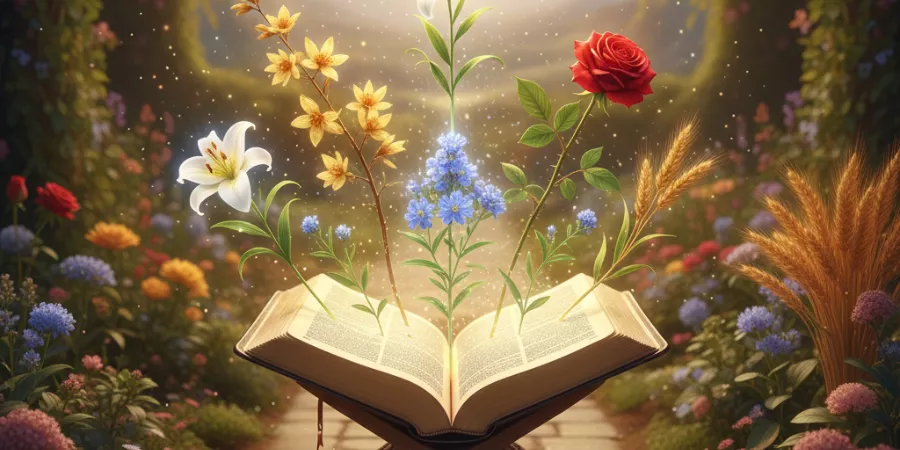In the land of Israel in biblical times, there were close to 500 different plants species that grew. Out of these, flowers in the Bible become especially significant as they were used extensively in the Bible as metaphors, symbols and helpers that bring back to the mind the deeper realm of truths.
For instance when Jesus said “Consider the lilies of the field” (Gospel of Matthew 6:28), He wasn’t only referring to the beauty of the flowers but rather he was pointing to the qualities of trust, care and value which are implied by the flowers. Because of this, readers often explore the meaning of flowers in scripture and biblical plant symbolism to understand these images more deeply.
What it comes down to is that flowers which are referred to in the Bible are not simply there for the sake of decoration, they are actually used to depict characters, promises or patterns. We will examine ten flowers or plants whose names are found in the Scripture, we will discover their importance and then we will illustrate how they relate to living our life. These patterns help explain the symbolism of flowers in the Bible explained in many study traditions and give a sense of what flowers represent in scripture.
1. Lily of the Field – purity and provision
The lily appears as a metaphor for care-free growth and divine provision. In Matthew 6:28, Jesus uses the Greek word krinon (often translated lily) to speak of how flowers grow without labor yet are adorned. According to one study, the lily in scripture symbolises “loveliness, purity, innocence.”
Think of a valley meadow full of lilies: humble, unassuming, yet beautiful. The image points to both our fragility and God’s attentiveness. When you notice a flower growing in a wild patch, it is a reminder that value and care go together. Many readers turn to lily of the field symbolism when they study flowers in the Bible and how these humble blooms carry spiritual meaning.
2. Rose (or “Rose of Sharon”) – love, beauty and restoration
When the phrase “I am the rose of Sharon, and the lily of the valleys” appears in Song of Solomon 2:1, the precise flower being referred to is debated. What matters is the metaphor: beauty, belovedness, flourishing. Some commentators link the “rose” imagery with the idea of restoration for barren ground (see Book of Isaiah 35:1-2). A wild desert springing into bloom becomes a sign of hope.
The rose symbol invites us to consider that beauty can arrive in unlikely places, and that love and restoration often go hand in hand. In this context, people sometimes explore the rose of sharon meaning within wider studies of biblical flowers and their meanings.
3. Myrtle – peace and blessing
The myrtle appears in Isaiah 55:13: “Instead of the thorn shall come up the fir tree, and instead of the brier shall come up the myrtle.” In that verse the transition from thorn to myrtle becomes a picture of transformation and blessing. Myrtle has been used in Jewish tradition as a sign of peace and prosperity.
In practical terms, when you plant a tree known for its fragrance and resilience, the metaphor is that peace is rooted in endurance and blessing. It invites reflection on how adversity can give way to fragrance. This theme helps explain interest in myrtle in the Bible when people study flowers in the Bible and the messages they carry.
4. Olive Blossom – endurance, peace and divine presence
When the psalmist states “I am like a green olive tree in the house of God”, the olive becomes more than a crop, it becomes a symbol of peace, endurance and ongoing care. (Psalm 52:8) The olive tree lives long, weathers drought, yields oil that becomes light, offering, healing.
In biblical landscapes the olive tree often stood as witness to moments of covenant, reconciliation and peace (for example the dove bringing back the olive leaf in Genesis 8:11). For a reader today, the olive reminds that spiritual life is both rooted and resilient. This is why people often reflect on olive tree symbolism scripture while exploring the broader flowers in the Bible theme.
5. Mustard Seed / Mustard Plant – faith and kingdom growth
In the parable of the mustard seed (Matthew 13:31-32 among others) Jesus uses the smallest of seeds to describe the kingdom of God. The mustard seed starts small and grows large enough that birds can nest in it. It is a vivid image of expansion from humble beginnings.
What this imagery offers is the idea that small faith, small beginnings, when placed in the right soil, can lead to something significant. If you imagine a tiny seed in your hand and then a broad bush in the field, you get the sense of promise and growth beyond expectation. Students of Scripture often turn to the mustard seed meaning Bible when studying biblical plant symbolism.
6. Hyssop – cleansing and spiritual renewal
In Psalm 51:7 the psalmist asks: “Purge me with hyssop, and I shall be clean; wash me, and I shall be whiter than snow.” Hyssop appears in many purification contexts in the Old Testament: cleansing rituals for lepers, sprinkling of blood, etc. The plant is modest, often growing on walls or rocks, yet used in sacred settings.
In real life, when we see a simple herb being used for sacred cleansing it prompts reflection: sometimes the modest is the most powerful. Hyssop speaks to renewal, humility and being made clean, not by our strength but by something outside our self. This is why the topic of hyssop in scripture appears in many guides that discuss biblical flowers and their meanings.
7. Almond Tree / Almond Blossom – hope, watchfulness and fulfilment
The almond tree appears in Jeremiah 1:11-12 when the prophet sees a branch of an almond tree and is told “I am watching over my word to perform it.” The Hebrew word for almond, shaqed, sounds like the word for watchfulness. Because almond trees flower early, before the full bloom of spring, they became symbols of hope and fulfillment.
Picture a tree bursting white blossoms while others still sleep: it signals that new life is coming. In our lives it may signal that promises are on their way even when winter still holds sway. This imagery often leads readers to explore the almond tree Bible meaning within the broader world of flowers in the Bible.
8. Balm of Gilead (or comparable bloom) – healing and comfort
While the precise flower “Balm of Gilead” may not be easily identified or translated, Scripture uses the idea of balm for healing, restoration and comfort. One can view comparable blooms that carry fragrance or opening for healing as symbolic of divine comfort.
The broader point is: blooms can stand for restoration not just aesthetics. For human experience this means that healing can come in delicate forms, some of them as simple as fragrance, colour or gentle growth. Because of this symbolism, many readers explore the balm of gilead symbolism while studying flowers in the Bible.
9. Crocus / Wildfield Flower – renewal and blessing
In Isaiah 35:1-2 we read “The desert and the parched land will be glad; the wilderness will rejoice and blossom like the crocus.” The crocus or wildflower in that setting is not cultivated but springs up in wild places. It becomes a metaphor for blessing arriving where least expected. In everyday life the idea is: even barren places, seasons of drought or wait, can become fertile, unexpected bloom happens.
When the wildflower appears, it invites us to look around and expect blessing, not just in gardens but in wastelands too. This is why some commentaries discuss the crocus in the Bible when explaining meaning of flowers in scripture.
10. Lily, Rose, Mustard, Hyssop — what they teach together
Taken together these flowers and plants carry a consistent message: life is rooted, humble grows, beauty emerges in unexpected places, renewal is possible, trust matters. The lilies show care. The mustard shows faith and expansion. The hyssop shows cleansing. The almond shows watching and promise. The rose or wildflower shows restoration.
What this really means is that symbolic language in Scripture matters because it connects the visible world to unseen realities. When you look at a simple bloom, you are not just admiring colour, you are engaging with metaphor. This is why many teaching guides focus on biblical flowers and their meanings and the biblical meaning of lilies roses hyssop and mustard as part of symbolism of flowers in the Bible explained.
Conclusion
When we recognise the symbolism behind flowers in the Bible we gain more than botanical trivia, we gain lenses through which to see our life. A lily growing in a field? It means you are worthy of care. A mustard seed? It means your small beginnings count. A hyssop twig? It means renewal is possible. The next time you walk past a wildflower, stop.
Consider that Scripture may be nudging you to see more. That a simple plant has meaning. That you have meaning. The clear takeaway is: faith, hope, renewal and beauty often arrive in humble, organic ways. They do not require grand settings. They emerge where we are. Take your cue from the field.













